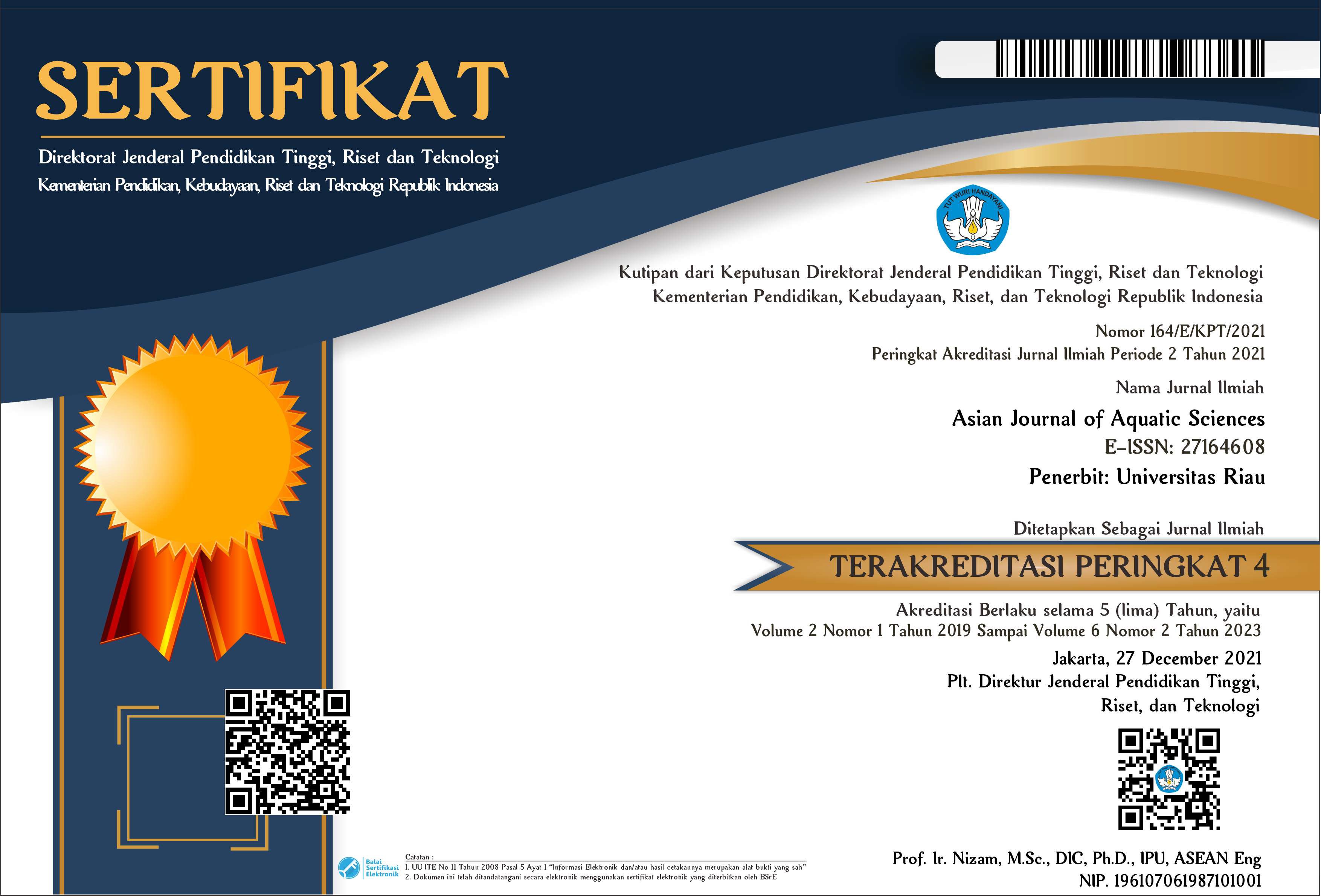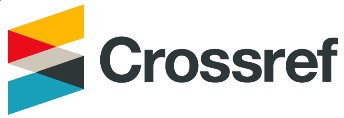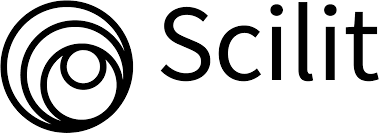GILL, KIDNEY, INTESTINE, AND LIVER STRUCTURES OF Pangasianodon hypophthalmus REARED UNDER BIOFLOC SYSTEM AND PHOTOPERIOD MANIPULATION
Abstract
Pangasianodon hypophthalmus is a freshwater fish that can grow well in dark condition. In no light condition, fishes are more responsive to feed provided. However, phytoplankton may not grow well, and as a consequence the water quality was poor and it negatively effects the fish health in general. The combination of biofloc and photoperiod manipulation systems is expected to improve the water quality as well as the fish health. To understand health status of the fish in general, the histological structure gill, kidney and liver was investigated. Sample were fixed in 5% formalin, paraffin processed and Haematoxylin Eosin stained. There were 2 factor, 3 treatment applied, namely natural (control), 18G (18 hours dark), 24G (24 hours dark) and 3 repetition. Parameter measured were survival rate and histological structure of gill, kidney, intestine and liver. Results shown that there are not difference of histological structure of the organs of fish reared under biofloc and manipulated photoperiod systems. There were light abnormalities in the gill, such as hyperplasia, hypertrophy, oedema and necrosis. There is no negative effect of biofloc system and photoperiod manipulation in structure of fish organ as there is only light abnormalities that can be cured when the water quality is good.
Downloads
References
Hendri, A. (2010). Manipulasi Fotothermal dalam Memacu Pematangan Gonad Ikan Senggaringan (Mystus nigriceps). Sekolah Pascasarjana Institut Pertanian Bogor.
Magwa, R.J. (2020). Aspek Biologi Ikan Patin (Pangasius hypophthalmus) yang Dipelihara dengan Manipulasi Fotoperiod dan Pemberian Pakan yang Diperkaya dengan Kunyit. Magister Ilmu Kelautan. Fakultas Perikanan dan Kelautan Universitas Riau.
Avnimelech, Y. (2007). Feeding with Microbial Flocs by Tilapia in Minimal Discharge Bio-Flocs Technology Ponds. Journal of Aquaculture. 264(1): 140-147
Putra, I., R. Rusliadi, M. Fauzi, U.M. Tang, Z.A. Muchlisin. (2020). Growth Performance and Feed Utilization of African Catfish Clarias gariepinus Fed a Commercial Diet and Reared in The Biofloc System Enchanced with Probiotic, F1000 Research. (6).
Windarti., A.H. Simarmata. (2017). Buku Ajar Histologi. Penerbit Unri Press. Pekanbaru. 105 hlm
Effendie, M. I. (2002). Biologi Perairan. Yayasan Pustaka Nusantara. Bogor.
Windarti. (2020). Keterampilan Dasar Biologi Perikanan. Penerbit Oceanum Press. Pekanbaru. 160 hlm.
Khairuman dan K. Amri. (2010). Peluang Usaha dan Teknik Budidaya lele Sangkuriang. PT. Gramedia Pustaka Utama. Jakarta.
Aryani, N., H. Syawal, I. Lukistyowati dan M. Riauwaty. (2016). Parasit dan Penyakit Ikan. Unri Press. Pekanbaru. 112 hlm.
Wahyuni, S., Windarti, R.M. Putra. (2017). Studi Komparatif Struktur Jaringan Insang dan Ginjal Ikan Gabus (Channa striata Bloch, 1793) dari Sungai Sibam dan Sungai Kulim Provinsi. Jurnal Online Mahasiswa.
Sugita, H., Okano, R., Suzuki, Y., Iwai, D., Mizukami, M. dan Akiyama, N. (2002). Antibacterial Abilities of Intestinal Bacteria from Larval and Juvenile Japanese Flounder against Fish Pathogens. Fish. Sci. 68: 1004-1011.
Firdasari, V. Yusfiati dan Roza Elvyra. (2014). Struktur Usus Ikan Ompok hypophthalmus (Bleeker 1846) dari Perairan Sungai Siak Kota Pekanbaru. Jurnal Online Mahasiswa. (1)
Riauwaty, M. (2013). Histopathology of Liver and Kidney of Pangasius hypopthalmus Infected with Aeromonas hydrophila and are Cured Using Curcuma xanthorrhiza Roxb Extract. Repository Unri.
Copyright (c) 2022 Alfred Nobel Pardede, Windarti, Efawani

This work is licensed under a Creative Commons Attribution-NonCommercial-NoDerivatives 4.0 International License.
Authors submitting manuscripts should understand and agree that the copyright of manuscripts of the article shall be assigned/transferred to the "Asian Journal of Aquatic Sciences". This work is licensed under a Creative Commons Attribution-NonCommercial-No Derivatives 4.0 International License, where Authors and Readers can copy and redistribute the material in any medium or format, as well as remix, transform, and build upon the material for any purpose, but they must give appropriate credit (cite to the article or content), provide a link to the license, and indicate if changes were made. If you remix, transform or build upon the material, you must distribute your contributions under the same license as the original.











